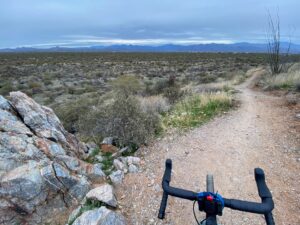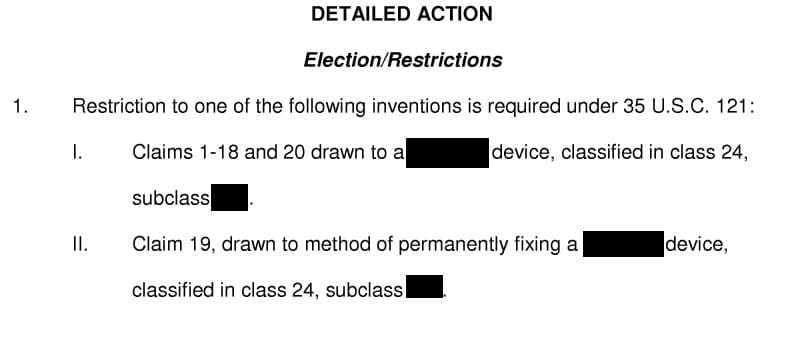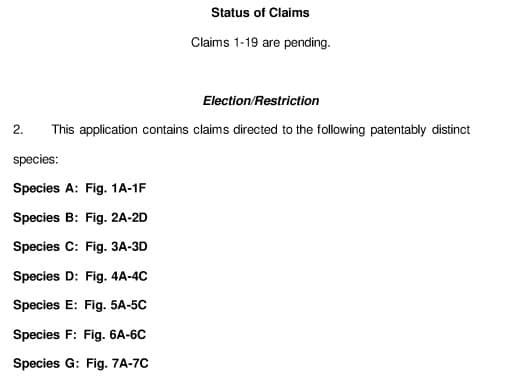Navigating Restriction Requirements in Patent Applications
If a Patent Examiner at the United States Patent and Trademark Office believes that your application claims more than one invention, he or she will issue a restriction requirement. Restriction requirements are incredibly common and are a normal part of patent application prosecution. They are one step in the long march through prosecution to issuance.
What is a Restriction Requirement?

Fundamentally, a restriction requirement is the USPTO’s way of asking you to pick one invention for prosecution in your application and remove the rest.
Both policy and practical considerations affect restriction practice. 35 U.S.C. § 121 states that “if two or more independent and distinct inventions are claimed in one application, the [Patent Office] may require the application to be restricted to one of the inventions.” Patent law wants to ensure that you submit only patentable idea in a patent application. There is a general rule of “one invention per patent.”
The Patent Examiner appreciates this. Examiners have an enormous number of patent applications to review. Why should Examiner A have to slog through a 200-page patent application that claims 15 different inventions while Examiner B next door churns through single-invention applications with only ten pages of specification?
As you can see, there are theoretical and fairness issues at play here. Examiners will issue a restriction requirement when an application:
- Contains multiple inventions;
- Those inventions are patentably distinct and different; and
- It would create a real burden on the Examiner to search multiple inventions and only get credit, or “counts,” for reviewing one patent application.
If this occurs, the Examiner will send you a restriction requirement. The restriction requirement will identify the different inventions the Examiner thinks are present in the application. In a restriction requirement, the Examiner will identify the claims of each invention and the type of invention. You can see an example below:
The above image is a classic restriction. The Examiner identifies claims drawn to a product (claims 1-18 and 20) and claims drawn to a method for using that product (claim 19). This is probably the most common type of restriction requirement.
You might also get something a little longer, like the image below. This snippet actually shows an election requirement, which is very similar to a restriction requirement. Below, the Examiner outlines a number of inventions in the patent drawings that appear to him to be different.
The restriction requirement will then explain that you have to pick one of the inventions the Examiner has identified. That is the invention that you would keep in this application, and you would most likely delete all others.
Restriction Requirement vs. Election Requirement
The two images above show slightly different actions. The first is a restriction requirement and the second is an election requirement. While technically different, these two communications are so similar that Examiners don’t even really distinguish them. Rather, they use the same form for both and just give it one title: “Election/Restriction.”
Both an election requirement and a restriction requirement force the patent applicant to pick one set of claims for prosecution in the current application.
But that requirement rests on different reasoning. A restriction requirement says there are multiple inventions recited within the claims. An election requirement, on the other hand, says that there are multiple species of the same invention. Often, but not always, this plays out with a restriction requirement based directly on what is recited in the claims, and an election requirement based on what is shown in the drawings.
As an example, the Examiner will issue a restriction requirement where a patent application includes claims on four different types of inventions. And the Examiner will issue an election requirement when there is only invention but there are multiple embodiments of it defining separate species.
The Patent Office might also send you a combined restriction and election requirement. I’ve seen a few of these in my career. This happens when the application presents at least two inventions and at least two species for one of those inventions.
While the line between restriction and election may seem blurry and strange, in most circumstances, it is largely a distinction without a difference. Both requirements mandate a response. You must pick what you are going to be moving forward with in your patent application.
Further complicating the matter, the Patent Office calls a response to a restriction requirement or an election requirement an election. You “elect” the invention or species you want to pursue, so your response is an “election,” whether you are responding to a restriction or election requirement.
Plan for a Restriction?
Savvy patent applicants will keep restriction practice in mind when preparing a patent application. Sometimes, applications grow large and include many, many inventions that, while different, are nonetheless linked somehow. In some situations, it may be desirable to write claims that cover all of the inventions to set up a restriction requirement. This will spawn divisional applications (discussed below) and could build a large family of patents.
On the other hand, presenting a large number of claims increases the cost of filing an application. I recently drafted an application with 57 claims. That was going to incur $5,040 in excess claim fees beyond the regular filing fees. However, we were confident that the application would receive a restriction requirement. Many of those 57 claims would end up being removed at the start of examination anyway. For this particular client, in their particular situation, it made more sense to drop the number of claims, get initial examination, and then file continuation applications.
Is a Restriction Requirement a Rejection?
If you are going to receive a restriction requirement, it will almost certainly arrive as the first action in the examination of your application. I suppose you could potentially have a restriction requirement in later stages of examination, but I have never seen one in my practice or anyone else’s.
Because it comes early, a restriction requirement shapes the scope of examination. It is not a rejection. Like a rejection, it requires a response by a deadline. But unlike a rejection, it does not point out what is “wrong” with the application. It does not raise prior art, and it does not identify grammatical issues or drawing errors or clarity problems.
Instead, a restriction requirement helps both the Examiner and the patent applicant identify which invention should be searched and reviewed by requiring the applicant to elect the desired invention. The application can move forward with all parties focused on a particular set of related claims.
Considerations in Responding to a Restriction Requirement
Preparing and filing a response to a restriction requirement is not as simple as identifying the elected invention. You must do that, but you must also identify the claims which encompass the elected invention. Sometimes the Examiner will do that for you (as is the case in the second picture above) but other times you must figure it out for yourself (if you get an election like in the first picture above).
Often, you will want to choose the claims that cover the go-to-market product or claims that cover a competitor’s offering. There may be other reasons to elect other claims, of course.
When you elect the claims covering the invention you want to pursue, you can either withdraw or cancel the claims drawn to the non-elected invention. It is rare that you want to cancel the claims, because doing so completely removes them. Rather, you may want to only withdraw them, so that they have the possibility to come back into the application later on through rejoinder. If you amend the non-elected claims through prosecution, you may make rejoinder easier later on.
You should also identify whether there are any linking or generic claims. Generic claims are claims that cover one or more (and sometimes) all of the inventions or species. If a generic claim is ultimately allowable, then all covered inventions or species are allowable as well. This can bring in inventions or species that were originally restricted out.
Timing is also an issue. Unlike an office action rejection, which sets a 3-month period for response, a restriction requirement has a 2-month shortened statutory period for response. You can respond after that, up to 6 months following the issue date of the restriction requirement, but you will have to pay an extension fee for each additional month.
Sometimes, you disagree with the restriction requirement. In those cases, you can make a traverse. Sometimes, you might want to traverse even if you agree with the Examiner, just to keep appeal and petition options open.
What is a Traverse?
A traverse is a formal argument explaining why the Examiner is wrong and why the claims should not be restricted in the way the Examiner suggests or at all.
A word of warning:
TRAVERSING A RESTRICTION REQUIREMENT IS ALMOST NEVER SUCCESSFUL!
Don’t think you can out-smart the Examiner with a traversal. I have responded to a lot of restriction requirements in my career. Very rarely have I found them objectively wrong. I’ve traversed them on that basis even less.
I can remember traversing a restriction requirement only twice, and I was successful both times. The first was when the Examiner completely misread the claims. His identification of the claim set was wrong, the numbering was wrong, and his explanations were off-base because of it. I traversed the restriction requirement. The Examiner really had no choice but to agree, and the application moved forward with all claims intact.
The second time I traversed was when the Examiner applied the wrong standard for the restriction. For reasons that never became clear to me, an Examiner reviewed the application like it was a national stage filing of a PCT application. In national stage applications coming from PCT applications, the Patent Office uses a standard called “unity of invention” to decide whether a restriction is proper. The Examiner sent a restriction requirement citing unity of invention. I traversed on the basis that the application was an original US filing, not a national stage filing. Again, the Examiner had no option but to admit a mistake. He did admit it, and then promptly sent us a new restriction requirement based on the correct US standard.
Traversing a rejection on the basis that the inventions are not that different or are not patentably distinct is a losing argument. Claiming that the Examiner does not actually have much of a burden in reviewing your multiple-invention application is also almost certainly not going to be persuasive. And if you find a mistake that the Examiner cops to, the Examiner will probably just end up correcting it a re-issued restriction requirement.
Further, there are risks to traversing. If you traverse on the grounds that the inventions identified by the Examiner are not distinct, and the Examiner later successfully rejects your claims on one of the inventions, that argument might get thrown back at you to show that your other inventions are also rejectable.
Even if you do traverse, you still have to elect your chosen invention. A response to a restriction is not complete unless it includes such an election. You can argue the restriction all you want. However, if you don’t ultimately elect claims, your response will be non-compliant and your application will face abandonment.
What Happens After a Restriction Requirement?
When you file a response to a restriction requirement and it is accepted, the application moves forward to substantive examination. Usually, the application is fresh to the Examiner’s desk, and so he or she will probably start reviewing it quickly. You may only wait a week or three to receive the next correspondence from the Examiner.
The restriction requirement focuses the Examiner on a set of claims covering one invention. The Examiner can now search and review those claims effectively and efficiently. The next correspondence will probably be an office action that raises formal and substantive issues with your application.
If you are successful in prosecution, your application will be allowed. This closes the prosecution phase of the application unless there is potential rejoinder.
What is Rejoinder?
Rejoinder is sort of the “un-restriction” of an application. It typically occurs at or near the end of prosecution. Rejoinder is the withdrawal of a restriction requirement between an allowable elected invention and a nonelected invention. It allows for the examination of the formerly non-elected invention on the merits.
When a claim on a non-elected invention depends from a claim that is ultimately held allowable, that claim can be rejoined. In rejoinder, the restriction requirement is withdrawn. The non-elected species covered by the rejoined claims is brought back into the application.
Divisional Applications
Restriction requirements set up divisional applications perfectly. In response to the restriction requirement, you will likely have elected one invention and withdrawn one or more non-elected inventions. You can now file a divisional application on the non-elected inventions.
The divisional application is structurally similar to your previous application because it contains the same drawings and disclosure. However, it does three distinct things:
- It will present claims that cover the non-elected inventions;
- It will identify itself as a divisional application to the previous application; and
- It will make a benefit claim to the previous application.
Moreover, because the divisional is filed as a result of restriction requirement in the previous patent application, 35 USC 121 says that the patent or publication issuing from the previous patent application cannot be used as prior art against the divisional. This means you can usually avoid a double-patenting rejection.
Thus, preparing claims in a first application for the possibility of restriction, and restricting them carefully, can allow you to build large families of patents that stretch out over time. These can be powerful tools against competitors.
You can read more about divisional applications here.
Summary
As you can see, while restriction requirements seem initially like simple actions to address, they actually involve complicated considerations. These must be at the front of your mind not only when responding to a restriction requirement, but when drafting the patent application years before. If you have any questions about restriction requirements or have received one and need help responding, feel free to call or contact Phoenix patent attorney Tom Galvani at 602-281-6481. He does not charge for consultations and always enjoys chatting with people interested in their patent applications.


